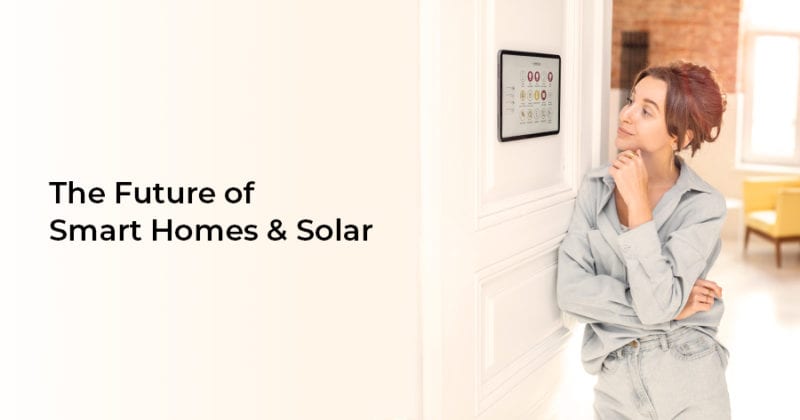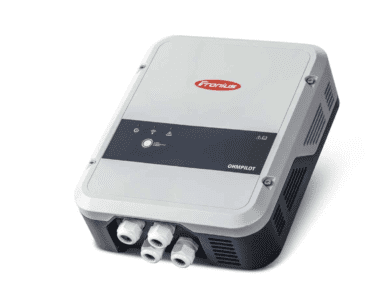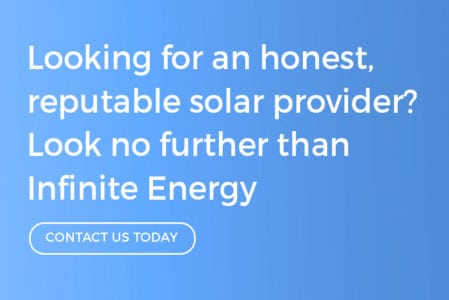The Future of Smart Homes & Solar

What will our homes look like in 5, 10, even 20 years’ time? One thing is for certain, technology will have advanced and our homes will operate almost independently without us needing to do so much as select an option on an app. Our homes will become significantly more energy efficient, as automation and artificial intelligence combined with renewable energy allow us to operate more effectively, contributing to lower electricity bills and increased ease of use. But before we can delve into what the future of home energy efficiency and technology looks like, it is important to understand what stage we are currently at and how solar and technology work in the home today.
What is a Smart Home?
A smart home consists of internal systems that can control appliances and other features within a home, such as lights or TV’s, via the internet. The appliances are connected through a central system, often referred to as a smart home management system or hub, that operates through your home broadband Wi-Fi and can be controlled remotely via an app on a smartphone or tablet. There are several smart home hubs available on the market that you may have already heard of, such as Amazon Alexa and Google Home.
Smart home hubs can perform a multitude of functions that are designed to provide convenience and improve our quality of life, such as setting the air conditioner to come on when you’re 20 minutes from home so the house is at your desired temperature when you arrive. They can also alert you when you’ve left an appliance on after you’ve left the house and turn it off at the touch of a button. Increased home security is even an area where smart devices can be useful.
Smart homes are designed to think intelligently, making “smarter” decisions, and ultimately thinking on their own. Multiple sources of information are fed into the central system, enabling the connected device to anticipate the most effective way of functioning and to provide a seamless experience. This is all done through the Internet of Things (IoT). The IoT, by definition is “a system of interrelated computing devices, mechanical and digital machines provided with unique identifiers and the ability to transfer data over a network without requiring human-to-human or human-to-computer interaction.”
Many new appliances and devices come with built-in functions that allow them to be used in a smart home, however add-on technology is often also available for older models.
Solar Online Monitoring
We always encourage our customers to maximise the use of their solar energy, as this provides the most valuable return on your investment. By shifting majority of your energy consumption to the day when the sun is shining and your panels are producing energy, you can improve your solar self-consumption.
However, using too many things at once can sometimes require more energy than your system is generating, so you may end up still needing to pull from the grid. Using your washing machine, dishwasher and pool pump all at the one time could do just this. Knowing exactly how much energy an appliance is using and how much your system is producing will help you make smarter choices about when to use energy in your home.
Today, inverters come with online monitoring capabilities, allowing you to access your system’s data on a desktop or app-based platform. However, entry level monitoring will only tell you how much your system is producing, it won’t tell you how much of that you’re consuming, and it usually lacks the ability to ‘control’ your energy usage. Although consumption monitoring is often an optional feature with an additional cost that you will need to request at the time of purchase, we highly recommend opting for this feature if available.
All of our inverters come with state-of-the-art online monitoring, with the additional option to have consumption capability.
Combining Smart Homes and Online Monitoring
While technology is certainly advancing, and we can control a multitude of devices through our smart home hubs, your solar system cannot be controlled through a smart home hub just yet. This is because the technology isn’t quite standardised in the industry to allow your inverter to communicate with them. Therefore, you cannot “control” how your solar PV system uses the energy it generates through one of these hubs, for example, you cannot program your pool pump to come on when there is a surplus of solar being generated by your system.
While you may be able to control your pool pump from your smart home app, you would have to cross-check your inverter online monitoring app to see how much energy is being generated to determine whether this would be feasible, and then go to your smart home app and turn on your pool pump.
What’s next?
Considering how fast technology moves these days, the ability to combine your smart home capabilities with your solar system into one platform may not be far off. We predict that the introduction of an industry standard for this kind of technology could see home owners have the ability to control how their system uses the energy it generates via a smart home hub, switching appliances on and off based on the amount of energy their system produces.
In the not-so-distant future, smart home automation will become a standard feature for newly built homes, with smart technology seamlessly integrated into every aspect. We will see all the same abilities that a smart home hub can perform now, only without the need for human assistance. Devices will be able to “learn” your behaviour by analysing data from multiple sources of information in your home through the IoT. For example, the home would be able to sense which member of the household is in a room, and automatically adjust the temperature of the room to that individual’s preference. It would mean having your coffee machine brewing a cup of coffee for you 5 minutes after your alarm goes off or placing an order with your local supermarket for groceries it knows you are getting low on.
The technology will make for a highly energy efficient home too, where heating, lighting, security, and a wealth of other features can act independently in accordance to the most energy efficient method. A future smart home would be able to turn the lights off when someone walks out of a room using motion detector sensors. Your smart home would also be able to communicate with the weather app to determine your likely solar production for the day, ensuring that your most energy intensive devices are only being used when there’s adequate solar generation. Battery storage will also play a crucial role in the future of energy efficiency in the home, with smart battery technology being able to load and dispatch energy at the most feasible time.
On top of this, electric vehicles will become a key staple of the Australian home, with an expected 1 million EVs on our roads by 2030. Your smart EV will be able to charge itself using your solar and battery storage system and will even be able to drive on autopilot or pick you up from a location independently.
What’s available now?
There are a few industry-leading inverter brands that have smart home features in their monitoring apps which can be used in conjunction with your devices. These work through devices that communicate with your appliances through the inverters Wi-Fi connection, and controlled through the inverter monitoring app. We’ve listed some examples below:
SolarEdge Smart Energy
SolarEdge inverters come equipped with online monitoring through the mySolarEdge app, where users can monitor the performance of their system, as well as a number of other features including controlling home appliances.
There are three main SolarEdge Smart Energy devices that can be managed through the mySolarEdge app:
- Smart Energy Hot Water: this device automatically directs surplus solar energy to heat your electric hot water system.
- Smart Energy Switch & Smart Socket: this device provides a wireless switch for controlling electrical loads, such as pool pumps, fans, lighting and other home appliances.
- Smart Energy Relay: this is a wireless relay for controlling high loads using an external control interface, such as a smart grid-ready supported heat pump
To enable these capabilities, a small ZigBee Plug-in is installed into the inverter when the smart energy devices are installed.
You can learn more about these features in the SolarEdge video here.
Fronius Ohm Pilot
The Fronius Ohmpilot is a consumption regulator that allows users to divert their excess solar power to be used to heat their hot water, or any other heating element that is considered ohmic. This is a particularly cost-effective feature, as a single shower can use more than 50 litres of hot water. The Fronius Ohmpilot allows up to 100% of the solar power generated by the solar PV system to be used, which can significantly lower electricity bills and make a home more self-sufficient.

Infinite Energy provides SolarEdge and Fronius inverters, which are considered some of the top inverters in the industry. By selecting one of these inverters to be used in your home solar system, you can access a range of benefits that many other inverters do not offer.
With so many new technologies on the horizon, it’s hard not to get excited about the future of home automation and energy efficiency. In the meantime, if you’d like to get started on your solar journey, simply request an obligation free quote or contact us today.


